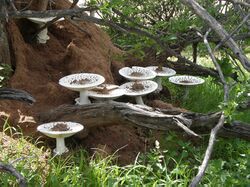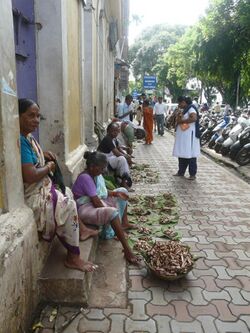Biology:Termitomyces
| Termitomyces | |
|---|---|

| |
| Termitomyces reticulatus | |
| Scientific classification | |
| Domain: | Eukaryota |
| Kingdom: | Fungi |
| Division: | Basidiomycota |
| Class: | Agaricomycetes |
| Order: | Agaricales |
| Family: | Lyophyllaceae |
| Genus: | Termitomyces R.Heim, 1942[1] |
| Type species | |
| Termitomyces striatus (Beeli) R.Heim
| |
| Synonyms[2] | |
|
1945 Podabrella Singer | |
Termitomyces, the termite mushrooms, is a genus of basidiomycete fungi belonging to the family Lyophyllaceae.[3] All of which are completely dependent on fungus-growing termites, the Macrotermitinae, to survive, and vice versa.[4] They are the food source for these termites, who enjoy an obligate symbiosis with the genus[5] similar to that between Atta ants and Attamyces mushrooms. Termitomyces mushrooms are edible, and are highly regarded for their flavor.[6]
Characteristics
Termitomyces includes the largest edible mushroom in the world, Termitomyces titanicus of West Africa and Zambia, whose cap reaches 1 metre (3.28 ft) in diameter.[7] It also includes Termitomyces microcarpus that grows caps of a few centimeters in diameter.
These fungi grow on 'combs' which are formed from the termites' excreta, dominated by tough woody fragments. Termitomyces was described by Roger Heim in 1942.[8]
From 1955 to 1969 Arthur French [9] worked in Uganda (as a hobby) on the subject of fungi and termites. Some scientific literature about these fungal species existed previously, but these texts failed to adequately discuss the relationship between termites and their fungal symbiotes, while the various edible varieties were merely termed "termite mushrooms." French conducted some investigations with the help of the elderly Baganda women who gathered termite mushrooms, and published his findings.
Life as a Termitomyces fungus
Some chamber(s) of the nest each contains a structure, called comb or fungus garden, where the fungus dwells.[10] The termites collect and chew up dead wood, leaf litter and other vegetable debris, depositing their primary faeces as new portions of the fungus garden.[11] The fungus grow through the comb. The termites eat spherules[note 1] and old combs.[12]
The fungus forms mushrooms for spreading spores. For most species, the fungus grows long pseudorhizas to the surface of the ground, where mushrooms are formed.[13] For T. microcarpus, the mushrooms grow from fragments of fungus garden that are carried outside the nest by worker termites.[14]
When a new termite colony is established, in most cases, the fungus is introduced through the activities of the termites collecting spores from the environment.[5]
Species
(As of July 2023), Species Fungorum accepted 52 species of Termitomyces.[15]
- Termitomyces acriumbonatus Usman & Khalid (2020)
- Termitomyces albidus (Singer) L.D. Gómez (1995)
- Termitomyces aurantiacus (R. Heim) R. Heim (1977)
- Termitomyces biyi Otieno (1966)
- Termitomyces bulborhizus T.Z. Wei, Y.J. Yao, Bo Wang & Pegler (2004)
- Termitomyces citriophyllus R. Heim (1942)
- Termitomyces clypeatus R. Heim (1951)
- Termitomyces congolensis (Beeli) Singer (1948)
- Termitomyces dominicalensis L.D. Gómez (1995)
- Termitomyces entolomoides R. Heim (1951)
- Termitomyces epipolius (Singer) L.D. Gómez (1995)
- Termitomyces eurrhizus (Berk.) R. Heim (1942)
- Termitomyces floccosus S.M. Tang, Raspé & S.H. Li (2020)
- Termitomyces fragilis L. Ye, Karun, J.C. Xu, K.D. Hyde & Mortimer (2019)
- Termitomyces fuliginosus R. Heim (1942)
- Termitomyces gilvus C.S. Yee & J.S. Seelan (2020)
- Termitomyces globulus R. Heim & Gooss.-Font. (1951)
- Termitomyces griseiumbo Mossebo (2003)
- Termitomyces heimii Natarajan (1979)
- Termitomyces indicus Natarajan (1976)
- Termitomyces infundibuliformis Mossebo (2012)
- Termitomyces intermedius Har. Takah. & Taneyama (2016)
- Termitomyces lanatus R. Heim (1977)
- Termitomyces le-testui (Pat.) R. Heim (1942)
- Termitomyces magoyensis Otieno (1966)
- Termitomyces mammiformis R. Heim (1942)
- Termitomyces mboudaeinus Mossebo (2003)
- Termitomyces mbuzi Härkönen & Niemelä (2021)
- Termitomyces medius R. Heim & Grassé (1951)
- Termitomyces microcarpus (Berk. & Broome) R. Heim (1942)
- Termitomyces narobiensis Otieno (1966)
- Termitomyces perforans R. Heim (1977)
- Termitomyces poliomphax (Singer) L.D. Gómez (1995)
- Termitomyces rabuorii Otieno (1966)
- Termitomyces radicatus Natarajan (1977)
- Termitomyces reticulatus Van der Westh. & Eicker (1990)
- Termitomyces robustus (Beeli) R. Heim (1951)
- Termitomyces sagittiformis (Kalchbr. & Cooke) D.A. Reid (1975)
- Termitomyces schimperi (Pat.) R. Heim (1942)
- Termitomyces sheikhupurensis Izhar, Khalid & H. Bashir (2020)
- Termitomyces singidensis Saarim. & Härk. (1994)
- Termitomyces songolarum (Courtec.) Furneaux (2020)
- Termitomyces spiniformis R. Heim (1977)
- Termitomyces srilankensis Ediriweera, Voto, Karun. & Kularathne (2023)
- Termitomyces striatus (Beeli) R. Heim (1942)
- Termitomyces subclypeatus Mossebo (2003)
- Termitomyces subumkowaan Mossebo (2003)
- Termitomyces titanicus Pegler & Piearce (1980)
- Termitomyces tylerianus Otieno (1966)
- Termitomyces umkowaan (Cooke & Massee) D.A. Reid (1975)
- Termitomyces upsilocystidiatus S.M. Tang, Raspé & K.D. Hyde (2020)
Taxonomic identity unknown
- Termitomyces meipengianus (M. Zang & D.Z. Zhang) P.M. Kirk (2014)
- Not a Termitomyces fungus; the actual taxonomic identity of this mushroom is unclear.[16]
Misnomer
- Termitomyces albuminosus (Berk.) R.Heim (1941)
- This name is commonly misused to refer to mushrooms of Termitomyces;[17][18] the original specimen of T. albuminosus was deemed to be of Macrolepiota and its species name became M. albuminosa.[19]
Other fungi associated with fungus-growing termites
Fungi of Pseudoxylaria, a subgenus of Xylaria, are found in fungus-growing termite combs.[20] Being weedy and controlled by fungus-growing termites,[21] they flourish when the termite nest is deteriorating or deserted.[20]
Lookalikes
- Many cases of mushroom poisoning in Malaysia happen because Chlorophyllum molybdites look similar to Termitomyces fungi.[22]
Culinary use
This genus is a popular wild seasonal delicacy in many places where it grows. One such place is the Indian state of Goa. For about two weeks at the beginning of August every year, clusters of villagers dot the Goan roadside hawking the handpicked mushrooms. A spicy gravy known as "Tonak" is a popular method of preparation. Since Termitomyces mushrooms are difficult to mass-produce, they command a high price.[23]
They are also foraged in Malaysia known as cendawan busut ("mound mushroom"). Tamil rubber tappers in Selangor long time ago would find a lot of T. schimperi growing in estate environments not long after raining.[24]:81
Notes
- ↑ Also known as mycotêtes.
References
- ↑ Dictionary of the Fungi (10th ed.). Wallingford, UK: CABI. 2008. p. 682. ISBN 978-0-85199-826-8.
- ↑ "Termitomyces R. Heim 1942". MycoBank. International Mycological Association. http://www.mycobank.org/MycoTaxo.aspx?Link=T&Rec=18637.
- ↑ "Plunging hands into the mushroom jar: a phylogenetic framework for Lyophyllaceae (Agaricales, Basidiomycota)". Genetica 143 (2): 169–94. 2015. doi:10.1007/s10709-015-9823-8. PMID 25652231.
- ↑ The Biggest Mushroom? — MykoWeb
- ↑ 5.0 5.1 "Dispersion and colonisation by fungus-growing termites". Communicative & Integrative Biology (Taylor & Francis) 3 (3): 248–250. 1 May 2010. doi:10.4161/cib.3.3.11415. PMID 20714406. PMC 2918769. https://doi.org/10.4161/cib.3.3.11415.
- ↑ "Some Records of Termitomyces from Old World Rainforests". Kew Bulletin (Springer Science+Business Media) 54 (3): 731–738. 1 January 1999. doi:10.2307/4110869. https://doi.org/10.2307/4110869.
- ↑ "Fungal biotechnology in food and feed processing". Comprehensive Biotechnology. 1 January 2011. pp. 613. doi:10.1016/b978-0-08-088504-9.00543-2. ISBN 9780080885049. https://doi.org/10.1016/b978-0-08-088504-9.00543-2.
- ↑ Heim R. (1942). "Nouvelles études descriptives sur les agarics termitophiles d'Afrique tropicale" (in French). Archives du Muséum National d'Histoire Naturelle 18 (6): 107–66.
- ↑ French A. (1993). "The Mushroom-Growing Termites of Uganda". Petits Propos Culinaires (44): 35–41.
- ↑ Luisa, Bozzano G. (2012). Insect-Fungus Interactions. Academic Press. pp. 71. ISBN 978-0-08-098453-7. https://books.google.com/books?id=DwO5_3N7sSAC&pg=PA71.
- ↑ "Cultivation of symbiotic fungi by termites of the subfamily Macrotermitinae". Symbiosis. Cellular Origin, Life in Extreme Habitats and Astrobiology. 4. 24 February 2006. pp. 737. doi:10.1007/0-306-48173-1_46. ISBN 1-4020-0189-4. https://doi.org/10.1007/0-306-48173-1_46.
- ↑ Batra, S.W.T. (1975). "Termites (Isoptera) Eat and Manipulate Symbiotic Fungi". Journal of the Kansas Entomological Society 48 (1): 89–92. https://www.jstor.org/stable/25082718.
- ↑ "Interactions with Humans and Other Animals". The Fungi. 1 January 2016. pp. 332. doi:10.1016/b978-0-12-382034-1.00009-8. ISBN 9780123820341. https://doi.org/10.1016/b978-0-12-382034-1.00009-8.
- ↑ Microbial symbionts: Functions and Molecular Interactions on Host. Elsevier. 9 September 2022. p. 663.
- ↑ "Species Fungorum - Termitomyces". http://www.speciesfungorum.org/names/names.asp?strGenus=Termitomyces&GSD=Yes.
- ↑ "Revision of Termitomyces in China". Mycotaxon 108 (1): 281. 2009. doi:10.5248/108.257. ISSN 0093-4666. http://dx.doi.org/10.5248/108.257.
- ↑ 唐保宏 (2006). 蚁巢伞属系统学及其与共生白蚁的协同进化研究 (PhD thesis). p. 90.
- ↑ 羊桂英; 郭梅霞; 于保庭; 胡寅; 莫建初 (2019). "白蚁共生真菌——蚁巢伞属研究概况". 菌物学报 38 (11): 1753. doi:10.13346/j.mycosystema.190288. http://manu40.magtech.com.cn/Jwxb/CN/10.13346/j.mycosystema.190288.
- ↑ "A revision of the genus Lepiota from Ceylon". Kew Bulletin 27 (1): 189. 1972. doi:10.2307/4117880. ISSN 0075-5974. http://dx.doi.org/10.2307/4117880.
- ↑ 20.0 20.1 "Adaptations of Pseudoxylaria towards a comb-associated lifestyle in fungus-farming termite colonies". The ISME Journal (Nature Portfolio) 17 (5): 733–747. 25 February 2023. doi:10.1038/s41396-023-01374-4. PMID 36841903. PMC 10119272. https://doi.org/10.1038/s41396-023-01374-4.
- ↑ "Fungus-Farming Termites Selectively Bury Weedy Fungi that Smell Different from Crop Fungi". Journal of Chemical Ecology (Springer Science+Business Media) 43 (10): 986–995. 1 October 2017. doi:10.1007/s10886-017-0902-4. PMID 29124530. https://doi.org/10.1007/s10886-017-0902-4.
- ↑ Phan Chia Wei (17 December 2018). "Preventing fatal harvest of mushrooms". Asia Research News. https://www.asiaresearchnews.com/html/article.php/aid/12290/cid/2/research/medicine/university_of_malaya/preventing_fatal_harvest_of_mushrooms.html. Retrieved 14 July 2023.
- ↑ "Wild Mushrooms of Goa". 5 August 2013. http://blog.parrikar.com/2013/08/05/wild-mushrooms-of-goa/.
- ↑ Hilton, Roger N.; Dhitaphichit, Pannee (1993). "Procedures in Thai Etnomycology". Natural History Bulletin of the Siam Society 41 (2): 75–92. https://thesiamsociety.org/nhbss_publications/vol-41-no-2-1993/.
See Tobias Frøslev's Termitomyces page [1] And an academic review of the relationship in Patterns of interaction specificity of fungus-growing termites and Termitomyces symbionts in South Africa Aanenet DK al BMC Evol Biol. 2007; 7: 115. [2]
External links
Wikidata ☰ Q2382732 entry
 |


